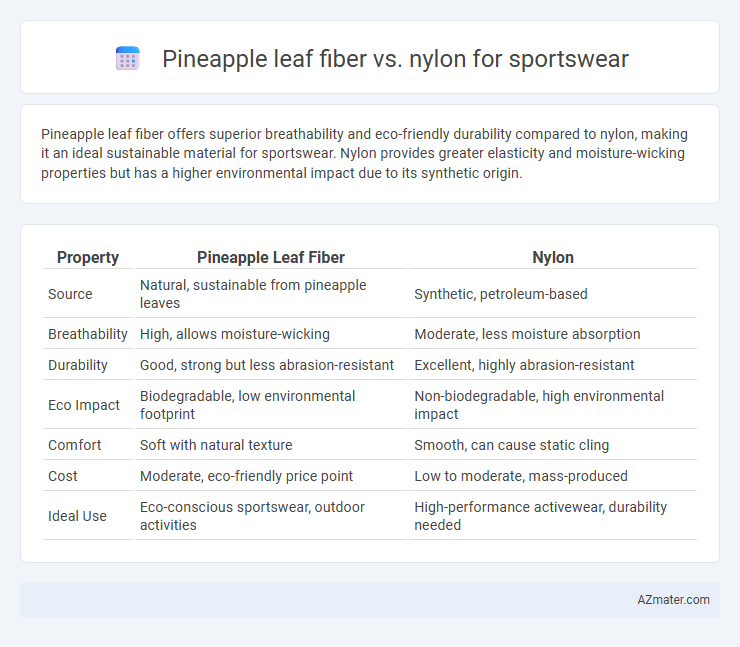Pineapple leaf fiber offers superior breathability and eco-friendly durability compared to nylon, making it an ideal sustainable material for sportswear. Nylon provides greater elasticity and moisture-wicking properties but has a higher environmental impact due to its synthetic origin.
Table of Comparison
| Property | Pineapple Leaf Fiber | Nylon |
|---|---|---|
| Source | Natural, sustainable from pineapple leaves | Synthetic, petroleum-based |
| Breathability | High, allows moisture-wicking | Moderate, less moisture absorption |
| Durability | Good, strong but less abrasion-resistant | Excellent, highly abrasion-resistant |
| Eco Impact | Biodegradable, low environmental footprint | Non-biodegradable, high environmental impact |
| Comfort | Soft with natural texture | Smooth, can cause static cling |
| Cost | Moderate, eco-friendly price point | Low to moderate, mass-produced |
| Ideal Use | Eco-conscious sportswear, outdoor activities | High-performance activewear, durability needed |
Introduction to Pineapple Leaf Fiber and Nylon in Sportswear
Pineapple leaf fiber is a sustainable, biodegradable natural fiber extracted from pineapple leaves, gaining popularity in sportswear for its breathability, moisture-wicking properties, and eco-friendly appeal. Nylon, a synthetic polymer, is widely used in sportswear due to its exceptional strength, elasticity, durability, and quick-drying capabilities. Comparing pineapple leaf fiber and nylon highlights the contrast between renewable plant-based materials and high-performance synthetic fabrics in athletic apparel innovation.
Material Composition and Sustainability
Pineapple leaf fiber, derived from natural plant cellulose, offers a biodegradable and renewable alternative to synthetic nylon, which is petroleum-based and non-biodegradable. The cellulose structure in pineapple fibers provides breathability and moisture-wicking properties, enhancing comfort in sportswear compared to nylon's moisture-retentive and less breathable characteristics. Sustainability benefits of pineapple leaf fiber include low environmental impact through agricultural waste utilization and reduced carbon footprint, contrasting with nylon's high energy consumption and pollutant emissions during production.
Production Processes and Environmental Impact
Pineapple leaf fiber (PALF) is produced through eco-friendly processes involving the extraction of fibers from pineapple leaves, utilizing mechanical decortication and retting, which minimize chemical use and reduce water pollution. Nylon manufacturing relies on energy-intensive petrochemical refining and polymerization, emitting significant greenhouse gases and non-biodegradable waste. The sustainable cultivation of pineapple leaves as an agricultural byproduct contrasts with the carbon footprint and non-renewable resource dependence of nylon production, making PALF a greener alternative for sportswear materials.
Moisture-Wicking and Breathability Comparison
Pineapple leaf fiber offers superior moisture-wicking capabilities due to its natural hydrophilic properties, effectively drawing sweat away from the skin to keep athletes dry during intense workouts. In contrast, nylon, a synthetic fiber, provides good breathability but can trap heat and moisture, often requiring chemical treatments to enhance its moisture management. Overall, pineapple leaf fiber is a more sustainable and naturally breathable option, while nylon excels in durability and stretch, making it less optimal for moisture control in sportswear.
Comfort and Skin Sensitivity
Pineapple leaf fiber offers superior breathability and moisture-wicking properties compared to nylon, enhancing overall comfort during physical activity. Its natural hypoallergenic characteristics reduce skin irritation, making it ideal for sensitive skin in sportswear applications. Nylon, while durable and stretchy, often traps heat and moisture, potentially causing discomfort and skin sensitivity for some users.
Durability and Performance Longevity
Pineapple leaf fiber offers exceptional biodegradability and moisture-wicking properties but generally falls short of nylon in tensile strength and abrasion resistance crucial for sportswear durability. Nylon boasts superior resilience, elasticity, and performance longevity under rigorous physical activity, maintaining shape and comfort over extended use. While pineapple fiber enhances sustainability, nylon remains the preferred choice for high-performance sportswear demanding long-lasting durability.
Weight and Flexibility for Athletic Use
Pineapple leaf fiber offers a lightweight and highly flexible alternative to nylon in sportswear, enhancing athlete mobility and comfort during intense activity. Its natural fibers provide breathability and moisture-wicking properties while maintaining durability comparable to synthetic nylon. Nylon, though strong and elastic, tends to be heavier and less breathable, which can impact long-term performance and comfort in athletic wear.
Cost Analysis and Market Availability
Pineapple leaf fiber offers a sustainable and eco-friendly alternative to nylon, with production costs generally lower due to its natural source, though processing expenses may vary based on technology and scale. Nylon remains widely available and cost-effective due to established manufacturing infrastructure and economies of scale, making it more accessible for mass-market sportswear. Market availability of pineapple leaf fiber is growing, driven by increasing demand for green materials, but it still lags behind nylon in volume and global distribution.
Consumer Preferences and Industry Trends
Pineapple leaf fiber is gaining traction in sportswear for its sustainability, breathability, and natural moisture-wicking properties, appealing to eco-conscious consumers seeking biodegradable alternatives to synthetic fibers. Nylon remains popular due to its durability, elasticity, and moisture management, making it a preferred choice for performance-focused athletes. Industry trends show a growing shift toward blending pineapple leaf fiber with nylon to create hybrid fabrics that combine environmental benefits with enhanced functionality.
Future Prospects for Pineapple Leaf Fiber in Sportswear
Pineapple leaf fiber offers a sustainable and biodegradable alternative to nylon in sportswear, boasting high tensile strength and moisture-wicking properties that enhance athletic performance. Innovations in fiber treatment and blending techniques are improving durability and elasticity, positioning pineapple leaf fiber as a viable eco-friendly substitute in high-performance garments. Ongoing research focuses on scalability and cost-efficiency, indicating a strong potential for pineapple leaf fiber to become a mainstream material in sustainable sportswear markets.

Infographic: Pineapple leaf fiber vs Nylon for Sportswear
 azmater.com
azmater.com